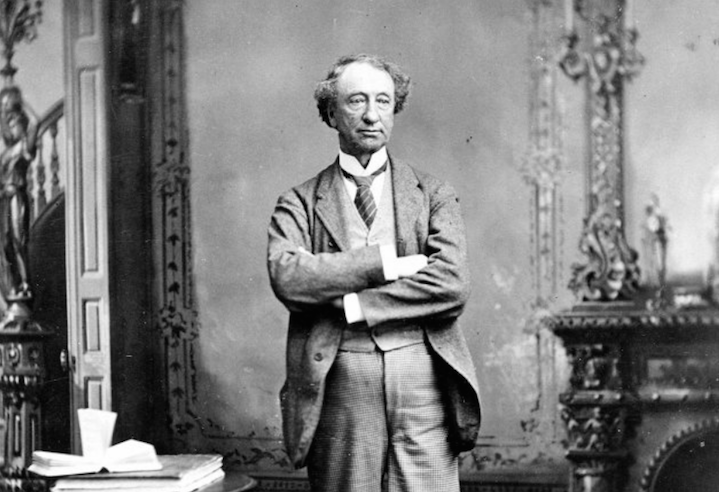Play critiques Sir John A. Macdonald for role in residential school system
By Floriane Bonneville
The play Sir John A: Acts of a Gentrified Ojibway Rebellion premiered on Oct. 3 at the NAC. As its title suggests, the theatrical performance is partly a critique of Canada’s first prime minister for his role in creating the residential schools system in Canada— inserting itself within the ongoing public dialogue about Sir John A. Macdonald’s place in Canadian history and legacy.
The writer of the play, Drew Hayden Taylor, takes a humorous but critical at Macdonald. But instead of simply slamming the man, the playwright has said he is trying to contextualize the Father of Confederation.
Macdonald has been the subject of much renewed debate since the 200th anniversary of his birth in 2015.
This summer, an Ontario teachers’ union stirred up controversy by suggesting Macdonald’s name be taken off schools across the province, because of his role in the creation of residential schools.
The uproar even prompted Liberal Prime Minister Justin Trudeau to defend the name of his Tory predecessor by saying “there are no plans by the federal government to (take) the name John A. Macdonald off of anything in our responsibility.”
The first PM’s name is everywhere in the capital, on roads, the international airport and buildings.
The name of Macdonald’s cabinet protégé Hector-Louis Langevin has also sparked debate over his central role in the creation of residential schools. Earlier this year, Trudeau announced that the Langevin Block on Wellington Street would be renamed “Office of the Prime Minister and Privy Council.”
The building, across Elgin street from the NAC, is barely a stone’s throw from where Taylor’s play is running from October 3-14.
Just down Wellington Street from there is the recently renamed Sir John A. Macdonald Building (rechristened by the Stephen Harper government to honour his conservative predecessor). And just further west, Wellington Street turns into the Sir John A. Macdonald Parkway, also recently named by the Harper government to replace the former Ottawa River Parkway.
Then there’s Ottawa’s Macdonald-Cartier International Airport, which includes statues of Macdonald and his French-Canadian lieutenant, George-Etienne Cartier, seated on a bench and greeting people arriving in the national capital.
Macdonald’s presence in Ottawa is decidedly strong, putting the capital at the centre of debate about the national patriarch.
Macdonald has recently been called the “corrupt, inebriated, racist father of Canada” by one writer and hailed as belonging in the “pantheon of great nation-builders” by another.
And his many contradictions are being examined by other artists. Along with Taylor’s play, a musical on Macdonald will be staged at Centrepointe Theatre in Nepean in November.
Taylor recently told Artsfile’s Patrick Langston that he believes few people, including Macdonald, wake up in the morning saying: “I will do evil things today. … It’s a mistake to eliminate bad people from history, from public consciousness, because you lose what people did and why and how it’s affecting us. But there still needs to be a certain amount of context.”
This makes sense to Chad Gaffield.
“Debates about how societies remember the past are always valuable, if sometimes difficult.” the University of Ottawa history professor said in an interview. The value about debates over history “includes helping us get perspective on issues today by coming to grips with how people faced related issues in the past.”
Gaffield says he believes that societies should never try to erase anything included in the historical record.
For Indigenous professor Hayden King, “the process that we’re in right now is a sort of a push and a pull on what is our common narrative as people that share this territory and there’s just disagreement over it and the resulting debate is just natural to that conflict.”
A professor at Carleton University’s School of Public Policy, King said that if Canadian society wants to see change in the relationship with Indigenous peoples, it will require discomfort and sacrifice. King, who is a member of the Ojibway nation, said he believes Canadians will have to grapple with the “myths and narratives that they’ve been told that were true since they came up to the education system from childhood to adulthood,” which include the perception of John A. Macdonald.
Earlier this year, Senator Murray Sinclair said renaming institutions whose names are offensive to Indigenous people is “counterproductive” because it does not bring balance. Rather, he said, people should honour Indigenous heroes.
King says he believes both should be done.
“By not discussing critically people like Sir John A. Macdonald or any of these other historical figures that have now been questioned we don’t do the important truth telling that Murray Sinclair himself advocated so passionately for throughout the Truth and Reconciliation process he chaired.
“If we want to name schools after Pontiac, or Tecumseh, or (Inuit leader) Mary Simon, or whoever, I mean, I think that we can do that too.”
Many see similarities with the debate in the U.S. over the taking down of Civil War general Robert E. Lee’s statue in Charlottesville, Virginia. Galen Perras, also a history professor at uOttawa, says the two issues are not the same. Perras says statues and buildings named for Macdonald were not made to display white power.
“Most of those Confederate statues were erected in the 1920s and then the 1950s and ’60s when the (Ku Klux) Klan revived and civil rights emerged to be deliberate reminders of white power,” Perras said.
This story was produced in collaboration with Artsfile.ca

